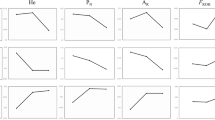Abstract
Recent studies in the literature have appliedphylogenetic methods based on genetic distancesto set priorities for conservation of domesticanimal breeds. While these methods may beappropriate for between-species conservation,they are clearly inappropriate forwithin-species breed conservation, because theyignore within-breed variation. In this paper weshow the basic tools to analyse geneticdiversity in subdivided populations withinspecies, and illustrate the errors incurred byapplying methods based exclusively on geneticdistances. We also show that maximisation ofgenetic diversity (minimisation of coancestryor kinship) is equivalent to maximisation ofeffective population size, as in undividedpopulations, and derive a generalisation ofprevious equations for the prediction ofeffective size. Finally, we discuss thestrategies for conservation in the light of thetheory.
Similar content being viewed by others
References
Barker JSF (1999) Conservation of livestock breed diversity. AGRI 25, 33–43.
Barker JSF (2001) Conservation and management of genetic diversity: A domestic animal perspective. Can J For Res, 31, 588–595.
Ballou JD, Lacy RC (1995) Identifying genetically important individuals for management of genetic diversity in captive populations. In: Population Management for Survival and Recovery (eds. Ballou JD, Gilpin M, Foose TJ), pp. 76–111. Columbia University Press, New-York.
Caballero A (1994) Developments in the prediction of effective population size. Heredity, 73, 657–679.
Caballero A, Toro MA (2000) Interrelations between effective population size and other pedigree tools for the management of conserved populations. Genet Res, 75, 331–343.
Chaiwong N, Kinghorn BP (1999) Use of genetic markers to aid conservation decisions for groups of rare domestic breeds. Proc Assoc Advmt Anim Breed Genet, 13, 365–368.
Cockerham CC (1967) Group inbreeding and coancestry. Genetics, 56, 89–104.
Crandall KA, Bininda-Emonds ORP, Mace GM, Wayne RK (2000) Considering evolutionary processes in conservation biology. TREE, 15, 290–295.
Crow JF, Kimura M (1970) An Introduction to Population Genetics Theory. Harper & Row, New York.
Frankham R (1995) Conservation genetics. Annu Rev Genet, 29, 305–327.
Krajewski C (1994) Phylogenetic measures of biovidersity: A comparison and critique. Biol Conserv, 69, 33–39.
Laval G, Iannuccelli N, Legault C, Milan D, Groenen MAM, Giuffra E, Andersson L, Nissen PH, Jørgensen CB, Beeckmann P, Geldermann H, Foulley J-L, Chevalet C, Ollivier L (2000) Estimation of the coancestry coefficient: Basis for a short term genetic distance. Genet Sel Evol, 32, 187–203.
Lynch M, Ritland K (1999) Estimation of pairwise relatedness with molecular markers. Genetics, 152, 1753–1766.
Malécot G (1948) Les Mathématiques de l'Hérédité. Masson et Cie, Paris, France.
Nei M (1973) Analysis of gene diversity in subdivided populations. Proc Natl Acad Sci, USA, 70, 3321–3323.
Nei M (1987) Molecular Evolutionary Genetics. Columbia University Press, New York.
Nei M, Chesser RK (1983) Estimation of fixation indices and gene diversities. Ann Hum Genet, 47, 253–259.
Oldenbroek JK (1999) Genebanks and the Conservation of Farm Animal Genetic Resources. DLO Institute for Animal Sciences and Health, Lelystad, The Netherlands.
Petit RJ, El Mousadik A, Pons O (1998) Identifying populations for conservation on the basis of genetic markers. Conserv Biol, 12, 844–855.
Pons O, Chaouche K (1995) Estimation, variance and optimal sampling of gene diversity II. Diploid locus. Theor Appl Genet, 91, 122–130.
Ponzoni RW (1997) Genetic resources and conservation. In: The Genetics of Sheep (eds. Piper LR, Ruvinsky A), pp. 433–466. CAB International.
Reynolds J, Weir BS, Cockerham CC (1983) Estimation of the coancestry coefficient: Basis for a short term genetic distance. Genetics, 105, 767–779.
Ruane J (1999) A critical review of the values of genetic distance studies in conservation of animal genetic resources. J Anim Breed Genet, 116, 317–323.
Takezaki N, Nei M (1996) Genetic distances and reconstruction of phylogenetic trees from microsatellite DNA. Genetics, 144, 389–399.
Thaon d'Arnoldi C, Foulley J-L, Ollivier L (1998) An overview of the Weitzman approach to diversity. Genet Sel Evol, 30, 149–161.
Toro MA, Barragán C, Óvilo C, Rodrigáñez J, Rodríguez C, Silió L (2001) Estimation of coancestry in Iberian pigs using molecular markers. Conserv Genet, submitted.
Wang J, Caballero A (1999) Developments in predicting the effective size of subdivided populations. Heredity, 82, 212–226.
Weitzman ML (1992) On diversity. Quart J Econ, 107, 363–405.
Weitzman ML (1993) What to preserve? An application of diversity theory to crane conservation. Quart J Econ, 108, 157–183.
Whitlock M, Barton NH (1997) The effective size of a subdivided population. Genetics, 146, 427–441.
Wimmers K, Ponsuksili S, Hardge T, Valle-Zarate A, Mathur PK, Horst P (2000) Genetic distinctness of African, Asian and South American local chickens. Anim Genet, 31, 159–165.
Wray NR, Thompson R (1990) Predictions of rates of inbreeding in selected populations. Genet Res, 55, 41–54.
Wright S (1969) Evolution and the Genetics of Populations. Vol. 2, The Theory of Gene Frequencies. The University of Chicago Press, Chicago, USA.
Author information
Authors and Affiliations
Corresponding author
Rights and permissions
About this article
Cite this article
Caballero*, A., Toro, M.A. Analysis of genetic diversity for the management of conserved subdivided populations. Conservation Genetics 3, 289–299 (2002). https://doi.org/10.1023/A:1019956205473
Issue Date:
DOI: https://doi.org/10.1023/A:1019956205473




